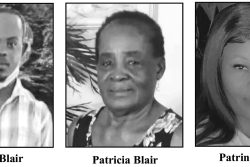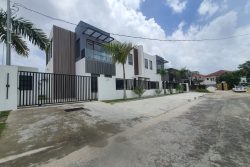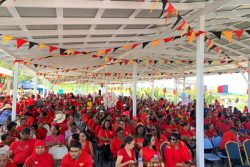An almost two-year battle by residents of Bel Air Park, Georgetown, to reclaim their community playground ended last Monday, when the High Court ruled that the land is to be used specifically for that purpose and no other.
The ruling was made against the Mayor and City Councillors (M&CC) of George-town, its Town Clerk and the Central Housing and Planning Authority, who in 2016 were attempting to convert the recreational space into residential house lots for the Mayor, Town Clerk, City Engineer and Medical Officer of Health.
The ruling was made by Justice Gino Persaud, who declared, among other things, that the intended use of the community reserve property by the respondents for the building of residential homes, was in breach of the servitude designating its use for community purposes only.
A servitude entitles the person who enjoys it to prohibit something or to do something for his own benefit, upon another’s land. Its registration in transport constitutes notice to all the world, of the existence of a real right.
The action was brought by attorney-at-law and Bel Air resident Devindra Kissoon, who argued that respondents, jointly and severally, were bound by the servitude attached to the Block R.3 and Lot C.l, part of Block R.4, Bel Air Park land.
Kissoon noted that the servitude is enforceable and binding upon the respondents as a real servitude under Roman-Dutch law, which applies to real servitudes in Guyana pursuant to section 3(d) (ii) of the Civil Law of Guyana Act Cap. 6:01.
Pointing out the deplorable state in which the community reserved has been, the judge also granted Kissoon a declaration he was seeking, that the M&CC and Town Clerk are under a duty to maintain it, pursuant to Section 302 (7) of the Municipal and District Councils Act.
Noting that Bel Air Park is plagued by severe flooding, Kissoon argued that this would be exacerbated if a structure were to be erected on the land.
He said that the M&CC and Town Clerk have failed in their duty to maintain the property, which has become overgrown and inaccessible for use by residents, thus “affecting their quality of life and their right to use the property for community recreational purposes.”
By virtue of Section 302(7) of the Municipal and District Councils Act, the M&CC is under an obligation to maintain sports grounds, theatres and promenade gardens in the Reserve, which falls within the category specified in section 302(7) of “open spaces and land vested in the M&CC.”
Kissoon, by letter dated February 17th, 2016, to Town Clerk Royston King, noted that the M&CC had illegally proceeded to make plans and issue public announcements concerning its intended use of the community property and had gone as far as erecting a security hut on Eping Avenue, which in part encroached the road.
The applicant said that though the M&CC was asked to desist from such action, King confirmed his intent in a television interview on Capitol News on or around January 20th, 2016.
Justice Persaud has declared that any Central Housing and Planning Authority permission or approval issued for the use of the property as residential housing or otherwise, other than for community purposes, is unlawful.
Minutes of the M&CC’s Statutory Meeting for August 14th, 2017, used by Kissoon as exhibits and seen by the newspaper, notes King approaching the Minister of Housing, as the administration was desirous of building a town house for the Mayor, Town Clerk and City Engineer and Medical Officer of Health.
By letter of May 16th, 2017 to King, local developer Terrence Taljit applied for permission to develop a portion of the Community Reserve Property for the purpose of constructing modern homes.
This was indicated in the meeting’s minutes also.
Kissoon said that by letter of letter of June 19th, 2017, to members of the Investment and Development Committee of the M&CC, King convened a meeting to discuss and approve, among other things, Taljit’s application to develop the Community Reserve Property.
Taljit’s application was then considered at the Council’s August 14th, 2017 Statutory Meeting.
The minutes from that meeting reveal that after discussing Taljit’s application, the recommendation was that the Committee agreed in principle to approving the application, provided that a detailed proposal was submitted and that the Committee then determine the way forward.
Those minutes also reveal that the M&CC and Town Clerk intended to build residential homes on the Community Reserve Property, in breach of the servitude.
Justice Persaud has granted an injunction, restraining the Town Clerk and the M&CC by themselves, their representatives, officers and or agents collectively and individually from using, leasing, transferring, assigning, conveying, licensing, selling, encumbering, dealing or permitting the use of the property for the purpose of building residential homes or otherwise other than for community purposes, or doing any act which would breach the Servitude contained in transport No. 1580.
According to Kissoon’s application, the servitude was created on October 6th, 1958 in Transport No. 1580 contained on Plan No. 6015, dated March 8th, 1952, which states that “no trade or industry whatsoever shall be carried on the said block and lot which are reserved for community purposes only.”
The applicant has always maintained that the servitude remained in full effect.
Justice Persaud has also ordered the Town Clerk to pay Kissoon cost in the sum of $50,000.










